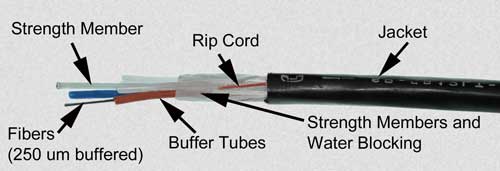Whether a cable contains a single optical fiber or several, it has a basic structure in common with other cables. As shown in Figure 7.2, a typical fiber optic cable consists of the optical fiber(made up of the core, cladding, and coating), plus a buffer, strength members, and an outer protective jacket. Let’s look at these components individually.
Buffer
While the fiber’s coating is the first non-optical protective layer surrounding the fiber, the buffer, which in turn surrounds the coating, providers a greater measure of protcetion as well as some tensile strength, which is useful when pulling the cable to install it or when it must hang between two suspension points. The buffer is also the first layer used to define the type of cable construction. Depending on the application, manufacures can provide loose-buffered or tight-buffered cables.
Loose Tube Buffering
Losse tube buffering consists of a buffer layer that has an inner diameter much larger than the diameter of the fiber, as shown in Figure 7.3. The primary purpose of loose tube buffering is to allow the fiber more room to move independently of the buffer and the rest of the cable. An important factor if the cable will be subjected to temperature extremes that cause expansion or contraction, changes in tension, or excessive bending. Figure 7.4 shows how the fiber inside the loose tube buffer is isolated from movement of the buffer and the rest of the cable.
Because the fiber is not connected to the buffer, it will usually follow a gently meandering path through the buffer, giving it some extra length. This is useful when the cable is streched—as it inevitably will be—since a small amount of stretching will only straighten the fiber out without putting any damaging tension on it.
Loose tube buffered cable may be single fiber or multimfiber(not to be confused with singlemode and multimode fiber), meaning that it may have one or many fibers running through it. In addition, a cable may contain a number of loose tube buffers grouped together, as shown in Figure 7.5. In such cables, loose tube buffers are grouped around a central core that provides added strength.
Loose tube buffered cable that is made for outdoor use may be filled with a gel that prevents water from getting in the cable. The gel aslo helps to cushion the fiber against any damage from shock or pressure and insulates it against rapid temperaure changes. In catalogs, these cables are reffered to as loose tube, gel-filled or LTGF cables. Here’s loose tube type ADSS cable from our Fiberstore, as shown in following picture.
Tight Buffering
Tight-buffered cable is used in more controlled environments where the cable is not subjected to changes in position, temperature, tension, or moisture. In short, tight-buffered cable is mostl used indoors. In data center, tight-buffered OM4 fiber optic cable are used in any data center looking for high speeds of 10G/40G/100G.
As shown in Figure 7.6, tight-buffered cable begins with a 250u optical fiber. The plastic buffer itself is 900u in diameter and is applied directly to the outer coating layer of the fiber. In this way, it resembles a conventional insulated copper wire. The buffer may have additional strength members running around it for greater resistance to stretching. Tigh-buffered cable is more flexible than loose tube buffered cable. With added protection against outside forces, tight-buffered cable can be used outdoors or in temporary setups where greater flexiblility is required.
The tight buffer provides added tensile strenght to the fiber, but does not isolate it from stretching and bending the way loose buffering does. Since the plastic, which is attatched directly to the fiber, expands and contracts with temperature at a different than the fiber itself, the different expansion rates can cause loss-inducing microbends. For this resaon, tight-buffered cable is most ofen used in areas where the cable is fixed in place and maintained in controlled conditions. If any microbending takes palce, however, the cable runs indoors are typically short enough to minimize attenuation problems.
Fiberstore has a long history of designing carefully engineered fiber optic cable for best-in-class performance, ease of use and flexibility. Our facility features state-of-the-art machinery continuously monitoring and maintaining optimum line speeds while simultaneously protecting the glass fiber. From simplex fiber constructions to large, armored multi-fiber cables. Need custom bulk fiber optic cable or one that integrates tight buffered cable, loose tubes or other length-based components into a single cable design? Fiberstore is the one for all of your optical fiber cabling needs.



